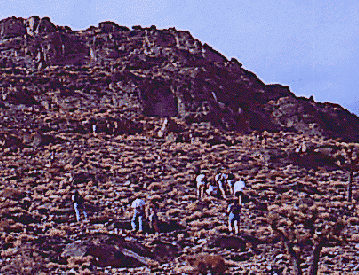Localities of the Cambrian:
The White-Inyo Mountains


Along the California-Nevada border north of Death Valley, the White Mountains, the Inyo Mountains, and associated ranges present one of the most important and best-known Late Proterozoic to Cambrian sections in the United States. Starting with the unfossiliferous Precambrian rocks of the Wyman Formation, paleontologists can work their way through a complete section that documents the appearance of various animals and protists, starting about 540 million years ago. Precambrian, Cambrian, and later Paleozoic rocks are also exposed to the south of the White-Inyo region, in Death Valley and in various ranges of the Mojave Desert.
 We bring you the intrepid undergraduate students of Dr. Jere
Lipps, climbing up "Rowland's Reef," located in the Silver Peak Range in
Esmeralda County, Nevada, right next door to the White Mountains. The
greyish rock that forms the steep upper part of the hill is in fact a
bioherm, or reef produced by living organisms; it is the oldest reef in
North America. "Rowland's Reef" was not made by corals -- reef-building
corals hadn't evolved yet -- but by
archaeocyathids
(extinct organisms related to
sponges)
and by carbonate-secreting
cyanobacteria.
Above and below the reef are fine shales, records of times when the
bottom of the Cambrian sea was subtidal and muddy. The shales of the
region often contain
trilobites,
brachiopods,
and occasionally other fossil forms.
We bring you the intrepid undergraduate students of Dr. Jere
Lipps, climbing up "Rowland's Reef," located in the Silver Peak Range in
Esmeralda County, Nevada, right next door to the White Mountains. The
greyish rock that forms the steep upper part of the hill is in fact a
bioherm, or reef produced by living organisms; it is the oldest reef in
North America. "Rowland's Reef" was not made by corals -- reef-building
corals hadn't evolved yet -- but by
archaeocyathids
(extinct organisms related to
sponges)
and by carbonate-secreting
cyanobacteria.
Above and below the reef are fine shales, records of times when the
bottom of the Cambrian sea was subtidal and muddy. The shales of the
region often contain
trilobites,
brachiopods,
and occasionally other fossil forms.
At the time when these rocks were being laid down, North America looked a little different from what it is today: it was tilted ninety degrees, so that what is now the White-Inyo region was along the north coast of the continent. It also lay close to the equator -- then, as now, reefs were most developed in low latitudes. Much of present-day California, as well as the southeastern United States, were not part of North America at the time; they would join the continent later.
 |
This closeup of the limestone that forms Rowland's Reef shows several archaeocyathids in cross-section; they are double-walled and appear round in this picture. (For scale, the lens cap in the picture is 50 millimeters across.) |
 |
A collection of oncolite fossils. These are spherical stromatolites formed in more turbulent marine conditions. |


